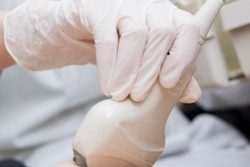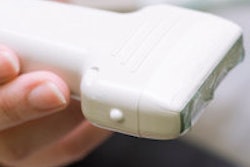Patients receiving ultrasound-guided interventional procedures have a low risk of serious infection complications, according to research published in the October issue of the American Journal of Roentgenology.
A research team from Hôtel-Dieu Grace Hospital in Windsor, Ontario, and the Mayo Clinic in Rochester, MN, reviewed two years of patient data at the Mayo Clinic and found only a 0.1% incidence of ultrasound-guided procedure-related infections. And nearly all the patients with infections improved from the use of antibiotics alone.
"Radiologists can use these data to provide more accurate information to patients when asking for consent before procedures and to reassure their patients," wrote the researchers, led by Patrick Cervini, MD, of Hôtel-Dieu Grace Hospital.
The study team reviewed Mayo Clinic data from January 1, 2006, through December 31, 2007, with the goal of determining the incidence of infection complications of common ultrasound-guided procedures such as fine-needle aspiration (FNA), drain placement, biopsy, pseudoaneurysm thrombin injection, thoracentesis, and paracentesis (AJR, October 2010, Vol. 195:4, pp. 846-850).
At the Mayo Clinic, the infection and prevention control committee performs prospective surveillance for selected positive cultures, including patients who have received radiology procedures. The radiology department also follows up on patients who have had hepatic, renal, and pancreatic biopsies for complications such as infections and hemorrhage, the researchers wrote.
Of the 13,534 percutaneous ultrasound procedures performed during the period on 8,419 patients, there were 11 likely and three possible procedure-related infections for a 0.1% overall incidence. The 14 infections included five abscesses, four bloodstream infections, four cases of peritonitis, and one urinary tract infection.
With a 0.2% infection rate (10 of 5,487 procedures), ultrasound-guided biopsy had the highest infection incidence; biopsy of a hepatic transplant had the highest individual incidence within this category at 1% (two of 192 procedures). The researchers found no infections after thoracentesis (2,849 procedures) and FNA (2,340 procedures).
Of those with infections attributed to ultrasound-guided intervention, nearly all patients improved on antibiotics, according to the researchers.
One patient required percutaneous drainage in addition to antibiotics, while another patient with a superficial abscess after lymph node biopsy required aspiration and antibiotics, the researchers found.
One patient died five days after paracentesis, but the death was likely due to multiorgan failure in the setting of fulminant liver failure with hepatorenal syndrome, the authors noted.
By Erik L. Ridley
AuntMinnie.com staff writer
September 21, 2010
Related Reading
Mayo says 3K patients at risk in hep C scandal, September 3, 2010
H1N1 crisis helped Canadian rads plan for future pandemics, May 11, 2010
French study shows how to reduce MRSA, March 23, 2010
Study finds bacterial contamination on portable x-ray units, August 13, 2009
Ultrasound probe cleaning education may be lacking, April 6, 2009
Copyright © 2010 AuntMinnie.com



















